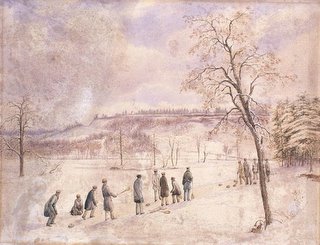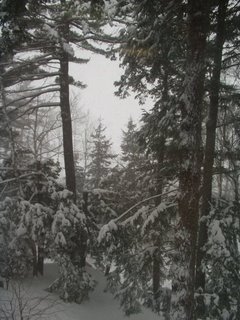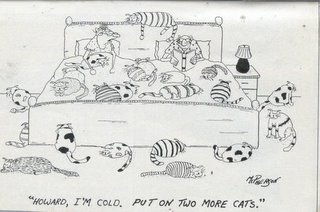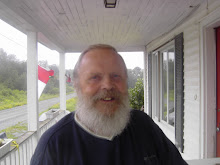Black History Month
Uncle Tom's Cabin, Dresden, Ontario
I couldn't let Black History Month pass without some comment. When I lived in the US. I was so involved in the Black community (I lived in the black neighbourhoods in Boston and New Haven over 10 years.) and their stuggle and history, I was once interview for a church job and from my resume they assumed I was Black.
Few Americans seem to be aware of the history of Blacks in Canada. I heard Oprah express surprise when she learned that their were Black Nova Scotians. From the beginning their have been Blacks, even some in slavery. There have been waves of immigration from the US, the Caribbean, Haiti, and Africa. Our mix of black population writes a different historical story to the Americans. In the US, the history of slavery taints all of the American Black experience. In Canada, there are other significant threads woven in the fabric of our Society.
The Underground Railroad and fugative slaves coming to Canada has its own history here.
http://www.africanhertour.org/story/index.html At the time, when Fugative Slave Laws saw escaping slaves hunted down in the US and returned to their masters ,Canada was a land of refuge with laws that protected Blacks rights as full citizens, owning property, having families, going to school and voting in elections. In the 1790's Lord Simcoe had made it illegal to bring slaves into Upper Canada (Ontario). Later in 1834, slavery was abolished in Canada. So prior to the American civil war, Canada was a shinning beacon of hope for fugative slaves. For a short time, they were a growing immigrant population. After the civil war many returned to the US to locate friends and relatives and participate in Reconstruction, a tribute to the pull of home and country. This was Canada's loss and Americans gain for many of these former slaves and their children, returned with significant educations and skills learned in their generational stay in Canada.
In the 1960's I read a book about one remarkable story of a black settlement in Canada, the Elgin Settlement. The book, "Look to the North Star" tells the story of a white Presbyterian Minister who inherited slaves from his wife, freed them and brought them to Canada, where the Free Presbyterian Church supported the creation of the 9ooo acre Elgin Settlement.
http://collections.ic.gc.ca/OBHO/books/non-fiction/biography/lookto.htmlI used to tell my American friends that this community was a model of Black Power ( in those days Black Power was debated in the US). It was a temporarily segregated community that the residents could not sell their land to whites for at least 10 years. If it had been the model for reconstruction the racial and social tension in US hjistory would have been much less.
In the Elgin Settlement the influence of Scottish Presbyerianism shaped it. It was hard, working, disciplined and sober. Families were granted land and had to work it hard. There were rules. For example, the house had to be close to the road with a porch across the front and a picket fence in front. (I imagine they looked much like the Uncle Tom's Cabin House in the picture above. (It is in another community not far from the Elgin Settlement. ) There were awards for the best looking homestead.
The school started by this community had a remarkable success. It was the first integrated school in Canada when local whites shut down their school and sent their children to the Eglin school. The first six graduate of this school went on the higher education and made significant contributions in Canada and the US. At one time, this school of the children of former slaves even taught Greek as a subject.
The Elgin settlement grew and prospered in agriculture. It also started some industries, sawmill and brick works.
http://www.ciaccess.com/~jdnewby/threshin.htmWith the outbreak of the Civil War and the formation of a Black Regiment in Michigan 70 men from the Elgin Settlement went signed up to fight for the North and the end of slavery.
http://www.geocities.com/cancivwar/USCT.htmlAt the end of the Civil War, many returned to the US. One became as legislator in Alabama and Freedmen Hospitals in Washington and Chicago were founded by former residents of the Elgin Settlement.
It is a wonderful history to read about. If you read nothing else during Black History Month, read the story of the Elgin Settlement. I was so fascinated that I once went to North Buxton to visit the remnant community of this historic community.
http://www.ciaccess.com/~jdnewby/black1.htm#Found%20on%20this%20page!
For links to 400 sites on the history of blacks in Canada visit
http://www.blackhistorycanada.ca/





















![[thinkingblogger.jpg]](https://blogger.googleusercontent.com/img/b/R29vZ2xl/AVvXsEhd9OJMeQzSRU2nO1UwIYEiYq7Fy8kqyJou32tkxFyT5DF7GZKLPBVzTtUsTFfGkc6_eQomd-V7nrSg-JEGTRZS378_-eJNQsvb0GIC23MStmn9e0sFTlq_xZ4ZID58dzqFKGXb/s1600/thinkingblogger.jpg)










 Add The Indicator To Your Site
Add The Indicator To Your Site

 Free Typing Tutor
Free Typing Tutor